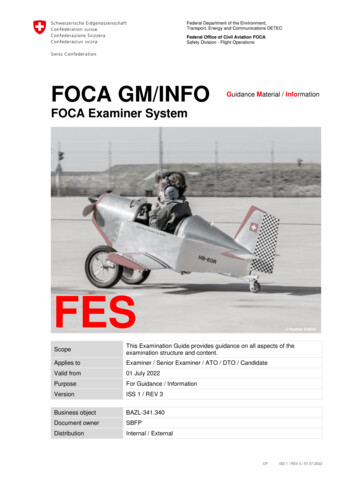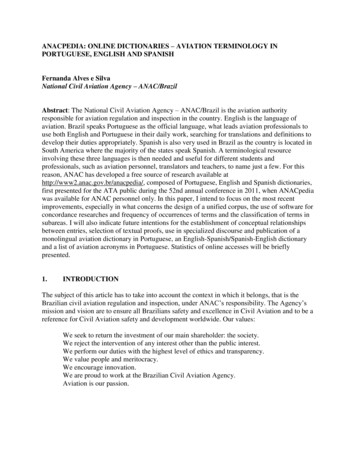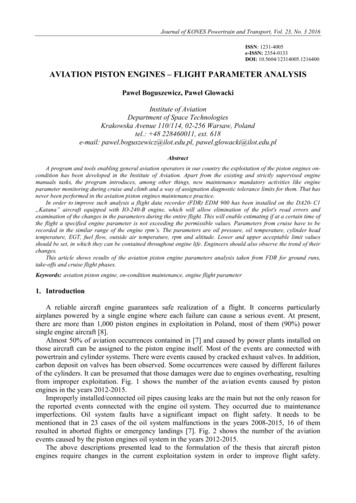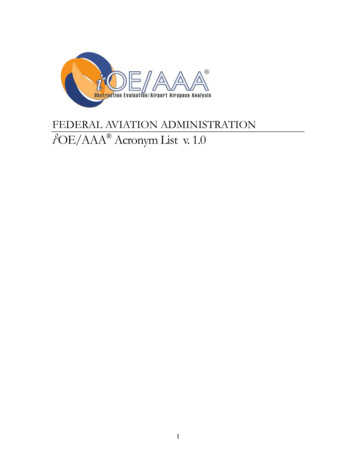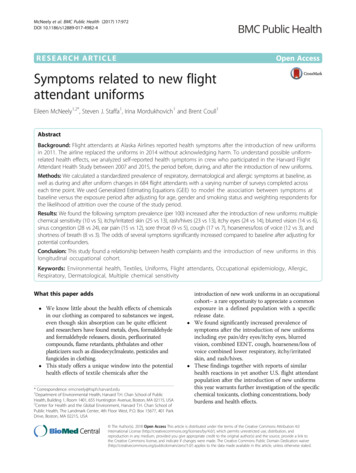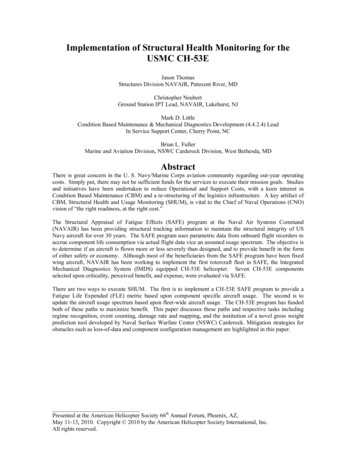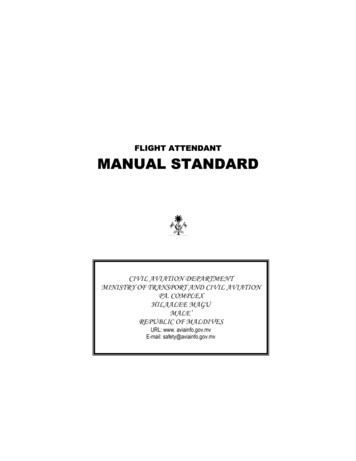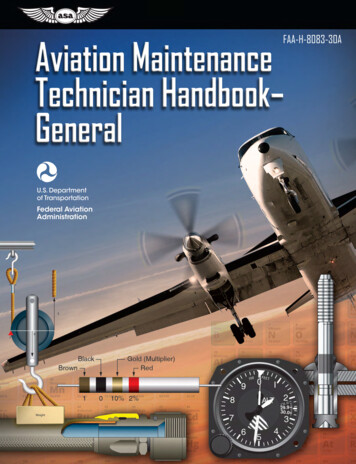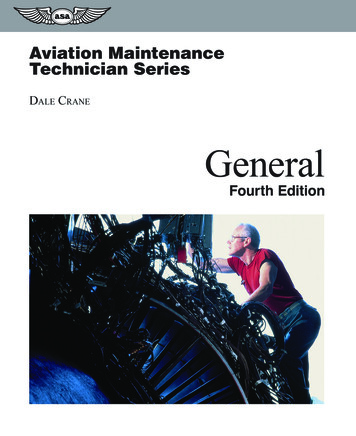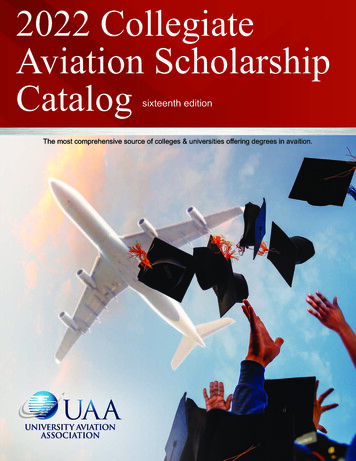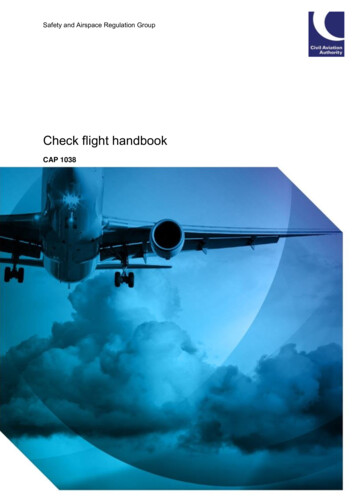
Transcription
Safety and Airspace Regulation GroupCheck flight handbookCAP 1038
CAP 1038Published by the Civil Aviation Authority, 2016Civil Aviation Authority,Aviation House,Gatwick Airport South,West Sussex,RH6 0YR.You can copy and use this text but please ensure you always use the most up to date version and use it in context so as not tobe misleading, and credit the CAA.First published 2013Second edition December 2016Enquiries regarding the content of this publication should be addressed to: ISPTechnicalSupportTeam@caa.co.ukThe latest version of this document is available in electronic format at www.caa.co.uk, where you may also register for e-mailnotification of amendments.January 2017
CAP 1038ContentsContentsContents . 1Revision history . 6Glossary . 7Introduction . 10Chapter 1 . 11The policy and background behind check flights . 11Introduction – The purpose of check flights . 11General . 12Background - terminology . 12EASA . 12Types of check flights . 13Check flight schedules . 14Implementation: Non-EASA aircraft . 17Introduction . 17Initial issue of C of A or National Permit to Fly . 18Renewal of a C of A or Permit to Fly . 18Check Flight Schedules (CFS) . 18Check flight results. 19Implementation: EASA aircraft. 19C of A issue – New aircraft. 19C of A Issue – Used aircraft from an EU Member State . 19C of A Issue – Used aircraft from a non-EU Member State . 19Light sport aircraft with an EASA Permit to Fly . 20C of A Issue – Export C of A from UK to a third country . 21Maintenance check flights . 21Chapter 2 . 23Airworthiness guidance - when to perform check flights . 23When a check flight is necessary and who can perform it . 23Introduction . 23Individual responsibility . 23When check flights should be performed . 24Airworthiness Check Flights (ACF) . 25January 2017Page 1
CAP 1038ContentsCheck Flight Schedules (CFS) (See Chapter 5) . 26Approved Pilots (See Chapter 3). 27Chapter 3 . 29Eligibility of pilots to carry out check flights. 29Introduction . 29Procedures . 29Experience and ability requirements . 30Administrative aspects. 30Chapter 4 . 32Insurance cover for check flights . 32Chapter 5 . 33Use of schedules currently or formerly published by the UK CAA . 33Owner/Operator-initiated check flights using schedules formerly published by the UK CAA . 33Applicability of CAA AFTS or CFS . 33Conduct and monitoring of check flights . 34Individual responsibility. 35Pilots, owners, licensed engineers, approved organisations . 35Airworthiness review signatory . 35Flight manuals . 36Availability of check flight schedules . 37Conclusion . 37Chapter 6 . 38Procedural aspects and preparation for a check flight . 38Introduction . 38Responsibility . 38Crewing . 39Insurance . 40Check Flight Safety . 40Limitations . 42Carriage of non-crew on check flights. 42Check flight conduct . 43Unserviceabilities . 45Weather. 45Unexpected results. 46Check flight checklist . 46January 2017Page 2
CAP 1038ContentsChapter 7 . 47Conduct of check flights on light aircraft . 47Introduction . 47External/Internal check . 47Taxying and engine run-up checks . 48Take-off and landing . 48Climb . 49Cruise check . 50Stalling . 50Recovering from the stall . 51Spinning . 52Flight to Vne . 52Functioning checks. 53Post Flight . 54Chapter 8 . 55Conduct of check flights on vintage and ex-military aeroplanes . 55Introduction . 55Check flight schedules. 55Check Flight Schedule 233 . 56Check flight schedule for renewal check flights . 56Check flight pilot qualifications. 56Experience requirements: single engine propeller aircraft . 57Experience requirements: single engine jet aircraft . 57Experience requirements: multi engine aircraft . 57Checks conducted in accordance with Check Flight Schedule 233 . 57Weather and operating limits . 58Safety equipment . 58Currency requirements . 59Conclusions . 59Chapter 9 . 61Conduct of check flights on light gyroplanes . 61Introduction . 61External/Internal check . 61Taxying and engine run-up checks . 61Take-off and landing . 62Climb . 62January 2017Page 3
CAP 1038ContentsCruise check . 63Steep turns . 63Minimum speed . 63Descent at idle power . 64Flight to Vne . 64Functioning checks. 65Post flight . 65Chapter 10 . 66Performance analysis fixed wing aircraft . 66Introduction . 66Interpretation of results . 66Calculation of rate of climb . 66Determination of mean values for performance determination . 70Climb performance assessment . 71Climb rate tolerances. 72Airworthiness check flights for all aircraft and series check flights of second-handimported aircraft . 72Submission of climb rate results . 74Chapter 11 . 76Post flight procedures and performance analysis: rotorcraft . 76After flight . 76Interpretation of results . 76Performance climb . 77Autorotation check . 79Chapter 12 . 80Post flight reporting . 80Appendix A . 81Guidelines on the experience requirements for pilots to be eligible for conducting check flights. 81Aeroplanes . 81Rotorcraft . 81Aircraft 5,700 kg . 82Appendix B . 84CAA contacts list . 84CAA Aviation House . 84UK Regional Offices . 85January 2017Page 4
CAP 1038ContentsAppendix C . 86Possible checklist items to be included in the planning of a check flight . 86Appendix D . 87List of documents required prior to conduct of a check flight . 87Appendix E . 88Example kneeboard schedule . 88Appendix F . 90List of documents required prior to conduct of a check flight . 90Appendix G. 91Example kneeboard schedule . 91Appendix H . 92Guidance on determination of achieved rate of climb . 92Introduction . 92Interpretation of results . 92Calculation of rate of climb . 92Determination of average check altitude and temperature . 93Appendix I . 96Climb performance tolerances . 96Introduction . 96Tolerances . 96Appendix J . 98Check flight certificate . 98Notes. 100General . 100Performance . 100Defects . 101Conclusions/Comments . 101January 2017Page 5
CAP 1038Revision historyRevision historyThis publication at Issue 2 replaces Issue 1 of the CAA Flight Check Handbook, dated 29November 2013 and previously available on the CAA website.January 2017Page 6
CAP 1038GlossaryGlossaryADAirworthiness DirectiveADDAircraft Deferred DefectADFAutomatic Direction FinderAFMAircraft Flight ManualAFTAirworthiness Flight Test (Airworthiness Flight Testing)AFTSAirworthiness Flight Test ScheduleAGLAbove Ground LevelAICAeronautical Information CircularAMCAcceptable Means of ComplianceAMOAircraft Maintenance OrganisationANOAir Navigation Order (CAP 393)AoAAngle of AttackAOCAir Operator’s CertificateAPUAuxiliary Power UnitARCAirworthiness Review CertificateARIAdditional Requirement for ImportASIAir Speed IndicatorATCAir Traffic ControlATPLAirline Transport Pilots LicenseAUWAll-Up WeightAWDAirworthiness DivisionBITEBuilt In Test EquipmentBCARBritish Civil Airworthiness RequirementsBMAABritish Microlight Aircraft AssociationC of ACertificate of AirworthinessC of VCertificate of ValidityCAMOContinued Airworthiness Management OrganisationCAPCivil Aviation PublicationCASCalibrated AirspeedCFSCheck Flight ScheduleCGCentre of GravityCRMCockpit Resource ManagementCTPChief Test PilotJanuary 2017Page 7
CAP 1038GlossaryDLSDesign Liaison SurveyorDMEDistance Measuring EquipmentDRDutch RollEASEquivalent AirspeedEASAEuropean Aviation Safety AgencyECLEngine Condition LeverEGTExhaust Gas TemperatureELAEuropean Light AircraftEPREngine Pressure RatioFADECFull Authority Digital Electronic ControlFMFlight ManualFTEFlight Test EngineerFWFixed WingIASIndicated Air SpeedICAOInternational Civil Aviation OrganizationILSInstrument Landing SystemIMCInstrument Meteorological ConditionsITTInter-Turbine TemperatureJARJoint Aviation RequirementsLAALight Aircraft AssociationLAMSLight Aircraft Maintenance ScheduleLSALight Sport AircraftMAUWMaximum All-Up WeightMELMinimum Equipment ListMMELMaster Minimum Equipment ListMmoMaximum Operating Mach NumberMORMandatory Occurrence ReportMTOWMaximum WeightMTWAMaximum Weight AuthorisedNfFree Turbine SpeedNgGas Generator RPMNrRotor RPMOATOutside Air TemperatureOEIOne Engine InoperativePOHPilots Operating HandbookRFMRotorcraft Flight ManualRNAVArea NavigationJanuary 2017Page 8
CAP 1038GlossaryROCRate of ClimbRPMRevolutions Per MinuteRRPMRotor RPMRWRotary WingSARGSafety and Airspace Regulation GroupSFCSpecific Fuel ConsumptionSHINESecond Hand Imported aircraft from a Non EC stateSOPStandard Operating ProcedureTLSType Liaison SurveyorTOTTurbine Outlet TemperatureTpTest PilotV2From BCAR Section DVFRVisual Flight RulesV mc(power on)Gyro Minimum Control Speed with power appliedV mc(power off)Gyro Minimum Control Speed with no power appliedVmcaMinimum Control Speed (Air)VminOn aircraft with full low speed protection, the speed at which the aircraftstabilizes with full nose-up pitch control and the engines at idle.VmoMaximum Operating SpeedVneNever Exceed SpeedVnoNormal Operating Limit SpeedVORVHF Omni directional RadioVtossTake Off Safety SpeedVyClimb SpeedZFWZero Fuel WeightJanuary 2017Page 9
CAP 1038IntroductionIntroduction1.This Handbook was originally produced by the Civil Aviation Authority as areference work for those pilots and FTEs carrying out Check Flights on UKregistered aircraft; as such, it was intended for use by those pilots who havepreviously received adequate familiarisation with check-flight techniques andsafety precautions and fully understood the significance and intent of the testsas well as the techniques used to minimise the risk associated with some tests.Furthermore, it has only ever been intended as an aide-memoire/refresher forpilots who have already been briefed: it is not a stand-alone trainingdocument.2.The scope of this edition of the Handbook is reduced from earlier editions. Thisis because the CAA is no longer able to support the level of detailed informationand guidance that has previously been provided. Nevertheless, it explains whoshould carry out Check Flights and offers a number of technical guides to thevarious aspects of the Check Flight. It is not intended to replace the contents ofan aircraft’s Flight Manual (or Permit to Fly) and where there is conflict betweenthis handbook and the equivalent documentation provided by the aircraftmanufacturer, the manufacturer’s documentation is always overriding.3.This Handbook does not apply to experimental or certification flight testing,whether on prototype or modified established types. Such flights are carried outunder ‘B Conditions’, ‘E Conditions’ or a Permit to Fly.4.This Handbook will not be subject to any further amendment, because the CAAis no longer able to offer up-to-date guidance on check flight procedures. Thereare a number of flight-test accredited organisations which can provide guidance,as well as courses offered by the aircraft manufacturers that cover the safeconduct of check flights.January 2017Page 10
CAP 1038Chapter 1: The policy and background behind check flightsChapter 1The policy and background behind check flightsIntroduction – The purpose of check flights1.1The ICAO Airworthiness Manual, Volume 1, states the purpose of airworthinessCheck Flights is to ensure that the aircraft’s flight characteristics and itsfunctioning in flight do not differ significantly from the normal characteristics forthe type and to check the flight performance against the appropriate sections ofthe flight manual.1.2The principles and safety considerations that follow are applicable for bothrequired and elective Check Flights for continuing airworthiness management.These Check Flights do not include maintenance Check Flights for specificitems; these are being covered by EASA through its rulemaking task (MDM.097(a) & (b))1.1.3The purpose of this Handbook is to advise owners and operators andorganisations involved in the management of the airworthiness of UK registeredaircraft of the current CAA policy for flight-checking both EASA and non-EASAaircraft. It is only intended as an aide-memoire/refresher for pilots who havealready been briefed: it is not a stand-along briefing document. This Chaptergives a summary overview of the present policy for import and the continuedairworthiness requirements for aircraft on the UK Register. More detail onparticular flight-checking techniques and requirements is given in the rest of thisHandbook.1.4For the purpose of this Handbook, applicable EC Regulations will be referred toas the EASA Regulations and aircraft subject to these Regulations will bereferred to as EASA aircraft. For non-EASA aircraft (which are defined in AnnexII to Regulation (EC) No 216/2008), British Civil Airworthiness Requirements(BCAR) remain applicable (see y 2017Page 11
CAP 1038Chapter 1: The policy and background behind check flightsGeneralBackground - terminology1.5Flight testing of aircraft provides a basis to establish compliance withcertification requirements for new aircraft and changes to aircraft. Other checkflights referred to as Check Flights or in-flight surveys, can be carried outperiodically on in-service aircraft as one of the processes to ensure that anaircraft continues to comply with the applicable airworthiness requirements.Additionally, maintenance Check Flights may be carried out following amaintenance activity on an aircraft to provide reassurance of performance orestablish the correct functioning of a s
1. This Handbook was originally produced by the Civil Aviation Authority as a reference work for those pilots and FTEs carrying out Check Flights on UK registered aircraft; as such, it was intended for use by those pilots who have previously received adequate familiarisation with check-flight techniques and
